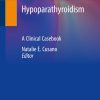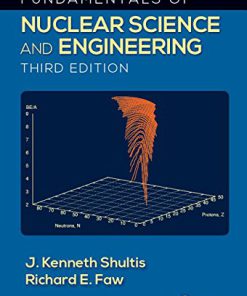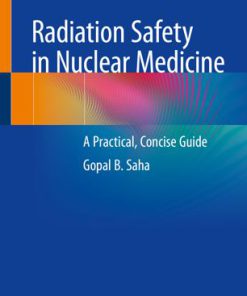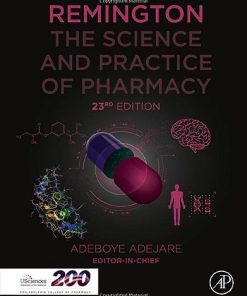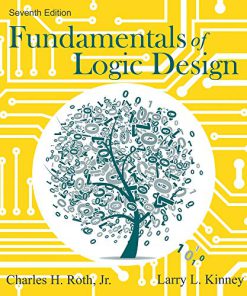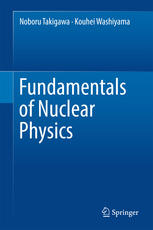Fundamentals of Nuclear Pharmacy 7th Edition by Gopal B Saha ISBN 3319575805 9783319575803
$50.00 Original price was: $50.00.$25.00Current price is: $25.00.
Fundamentals of Nuclear Pharmacy 7th Edition by Gopal B Saha – Ebook PDF Instant Download/Delivery: 3319575805, 9783319575803
Full download Fundamentals of Nuclear Pharmacy 7th Edition after payment
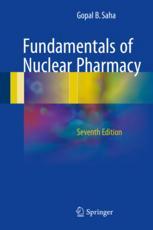
Product details:
ISBN 10: 3319575805
ISBN 13: 9783319575803
Author: Gopal B Saha
Currently an estimated 17 million nuclear medicine procedures are performed each year in the US and constantly evolving, as new radiopharmaceuticals and imaging techniques are introduced for better diagnosis and treatment of human diseases. In keeping up with new developments, the Seventh Edition of Fundamentals of Nuclear Pharmacy chronicles the advancements in radiopharmaceuticals and their use in clinical applications. It discusses basic concepts such as the atom, radioactive decay, instrumentation and production of radionuclides, and explores the design, labeling, characteristics and quality control of radiopharmaceuticals. Radiation regulations and diagnostic and therapeutic applications of radiopharmaceuticals are detailed. Thoroughly updated, the Seventh Edition includes new topics such as alternative productions of 99Mo; production of 64Cu, 86Y, 89Zr, 177Lu, 223Ra; synthesis and clinical uses of new radiopharmaceuticals such as DaTscan, Xofigo, Amyvid, Neuraceq, Vizamyl, Axumin and 68Ga-DOTATATE; dosimetry of new radiopharmaceuticals; theranostic agents and translational medicine. It features numerous examples, diagrams, and images to further clarify the information and offers end- of-chapter questions to help readers assess their comprehension of the material. Recognized as a classic text on nuclear chemistry and pharmacy and acclaimed for its concise and easy-to-understand presentation, Fundamentals of Nuclear Pharmacy is an authoritative resource for nuclear medicine physicians, residents, students, and technologists.
Fundamentals of Nuclear Pharmacy 7th Table of contents:
1: The Atom
1.1 Electronic Structure of the Atom
1.2 Chemical Bonds
1.2.1 Electrovalent or Ionic Bond
1.2.2 Covalent Bond
1.2.3 Coordinate Covalent Bond
1.2.4 Complex Formation
1.3 Structure of the Nucleus
1.3.1 Nomenclature
Suggested Reading
2: Radioactive Decay
2.1 Decay of Radionuclides
2.1.1 Spontaneous Fission
2.1.2 Alpha Decay (α-Decay)
2.1.3 Beta Decay (β–-Decay)
2.1.4 Positron or β+-Decay
2.1.5 Electron Capture
2.1.6 Isomeric Transition
2.2 Radioactive Decay Equations
2.2.1 General Equation
2.2.2 Half-Life and Mean Life
2.2.3 Units of Radioactivity
2.2.4 Calculations
2.3 Successive Decay Equations
2.3.1 General Equation
2.3.2 Transient Equilibrium
2.3.3 Secular Equilibrium
2.4 Statistics of Counting
2.4.1 Error, Accuracy, and Precision
2.4.2 Standard Deviation
2.4.3 Standard Deviation of Count Rates
2.4.4 Propagation of Errors
Suggested Reading
3: Instruments for Radiation Detection and Measurement
3.1 Gas-Filled Detectors
3.1.1 Dose Calibrators
3.1.2 Geiger–Müller Counters
3.2 Scintillation-Detecting Instruments
3.2.1 Collimator
3.2.2 Detector
3.2.3 Photomultiplier Tube
3.2.4 Preamplifier
3.2.5 Linear Amplifier
3.2.6 Pulse Height Analyzer
3.2.7 Display or Storage
3.3 Scintillation Camera
3.3.1 Collimator
3.3.2 Detector
3.3.3 X, Y Positioning Circuit
3.3.4 Pulse Height Analyzer
3.3.5 Digital Image
3.3.6 Display and Storage
3.4 Tomographic Imagers
3.4.1 Single-Photon Emission Computed Tomography
3.4.2 Positron Emission Tomography
3.4.3 PET/CT, PET/MR, and SPECT/CT
Suggested Reading
4: Production of Radionuclides
4.1 Cyclotron-Produced Radionuclides
4.1.1 Gallium-67
4.1.2 Iodine-123
4.1.3 Iodine-124
4.1.4 Germanium-68
4.1.5 Strontium-82
4.1.6 Indium-111
4.1.7 Copper-64
4.1.8 Thallium-201
4.1.9 Zirconium-89
4.1.10 Carbon-11
4.1.11 Nitrogen-13
4.1.12 Oxygen-15
4.1.13 Copper-62
4.1.14 Fluorine-18
4.2 Reactor-Produced Radionuclides
4.2.1 Fission or (n, f) Reaction
Yttrium-90
Molybdenum-99
Iodine-131
Xenon-133
4.2.2 Neutron Capture or (n, γ) Reaction
Phosphorus-32
Strontium-89
Iodine-125
Gadolinium-153
Samarium-153
Lutetium-177
Rhenium-186
Tungsten-188
Radium-223
4.3 Target and Its Processing
4.4 Equation for Production of Radionuclides
4.5 Specific Activity
References and Suggested Reading
5: Radionuclide Generators
5.1 Principles of a Generator
5.2 Important Radionuclide Generators
5.2.1 99Mo–99mTc Generator
Liquid Column Generator
Solid Column Generator
Yield of 99mTc
99mTc Content in 99mTc-Eluate
Quality Control of 99mTc-Eluate
99Mo Breakthrough
Other Radionuclide Contamination
Aluminum Breakthrough
pH
Radiochemical Purity
5.2.2 68Ge–68Ga Generator (GalliaPharm)
5.2.3 90Sr–90Y Generator
5.2.4 62Zn–62Cu Generator
5.2.5 82Sr–82Rb Generator (Cardiogen-82)
5.2.6 227Ac → 227Th → 223Ra Generator
References and Suggested Reading
6: Radiopharmaceuticals and General Methods of Radiolabeling
6.1 Definition of a Radiopharmaceutical
6.2 Ideal Radiopharmaceutical
6.2.1 Easy Availability
6.2.2 Short Effective Half-Life
6.2.3 No Particle Emission
6.2.4 Decay by Electron Capture or Isomeric Transition
6.2.5 High Target-to-Nontarget Activity Ratio
6.3 Design of New Radiopharmaceuticals
6.3.1 General Considerations
6.3.2 Factors Influencing the Design of New Radiopharmaceuticals
Compatibility
Stoichiometry
Charge of the Molecule
Size of the Molecule
Protein Binding
Solubility
Stability
Biodistribution
6.4 Methods of Radiolabeling
6.4.1 Isotope Exchange Reactions
6.4.2 Introduction of a Foreign Label
6.4.3 Labeling with Bifunctional Chelating Agents
6.4.4 Biosynthesis
6.5 Important Factors in Labeling
6.5.1 Efficiency of Labeling
6.5.2 Chemical Stability of Product
6.5.3 Denaturation or Alteration
6.5.4 Isotope Effect
6.5.5 Carrier-Free or No-Carrier-Added State
6.5.6 Storage Conditions
6.5.7 Specific Activity
6.5.8 Radiolysis
6.5.9 Purification and Analysis
6.5.10 Shelf-Life
6.6 Specific Methods of Labeling
6.6.1 Radioiodination
Principles of Iodination
Methods of Iodination
Triiodide Method
Iodine Monochloride Method
Chloramine-T Method
Electrolytic Method
Enzymatic Method
Conjugation Method
Demetallation Method
Iodogen Method
Iodo-Bead Method
Radioiodinated Compounds
6.6.2 Labeling with 99mTc
General Properties of Technetium-99m
Chemistry of Technetium
Reduction of 99mTc
Labeling with Reduced Technetium
Free Pertechnetate in 99mTc-Radiopharmaceuticals
Hydrolysis of Reduced Technetium and Tin
Formation of 99mTc-Complexes by Ligand Exchange
6.6.3 Structure of 99mTc-Complexes
6.6.4 Oxidation States of 99mTc in 99mTc-Radiopharmaceuticals
Tc7+
Tc5+
Tc4+
Tc3+
Tc1+
6.6.5 Oxidation States in 99mTc-Labeled Proteins
6.6.6 Kits for 99mTc-Labeling
6.7 Colloids and Labeled Particles
6.8 Additives and Preservatives
References and Suggested Reading
7: Characteristics of Specific Radiopharmaceuticals
7.1 99mTc-Labeled Radiopharmaceuticals
7.1.1 99mTc-Sodium Pertechnetate
7.1.2 99mTc-Macroaggregated Albumin
7.1.3 99mTc-Phosphonate and Phosphate Radiopharmaceuticals
7.1.4 99mTc-Sulfur Colloid
7.1.4.1 Filtered 99mTc-Sulfur Colloid
7.1.5 99mTc-Albumin Colloid (Nanocolloid)
7.1.6 99mTc-Tilmanocept (Lymphoseek)
7.1.7 99mTc-Pentetate (DTPA)
7.1.8 99mTc-Labeled Red Blood Cells
7.1.8.1 In Vitro Method
7.1.8.2 In Vivo Method
7.1.8.3 Modified In Vivo Method
7.1.9 99mTc-Iminodiacetic Acid Derivatives (Hepatolite, Mebrofenin)
7.1.10 99mTc-Hexamethylpropylene Amine Oxime (Ceretec)
7.1.11 99mTc-Sestamibi (Cardiolite, Miraluma)
7.1.12 99mTc-Mercaptoacetylglycylglycylglycine (MAG3)
7.1.13 99mTc-Ethyl Cysteinate Dimer (Neurolite)
7.1.14 99mTc-Tetrofosmin (Myoview)
7.1.15 99mTc-Dimercaptosuccinic Acid (Succimer)
7.1.16 99mTc-Technegas
7.2 Radioiodinated Radiopharmaceuticals
7.2.1 131I-Sodium Iodide
7.2.2 123I-Sodium Iodide
7.2.3 125I-Albumin
7.2.4 123I-Ioflupane (DaTscan)
7.2.5 123I- or 131I-Metaiodobenzylguanidine (AdreView)
7.2.6 125I-Sodium Iothalamate (Glofil)
7.3 Miscellaneous Radiopharmaceuticals of Clinical Interest
7.3.1 111In-DTPA
7.3.2 133Xe Gas
7.3.3 201Tl-Thallous Chloride
7.3.4 67Ga-Citrate
7.3.5 32P-Sodium Orthophosphate
7.3.6 89Sr-Strontium Chloride (Metastron)
7.3.7 153Sm-Ethylenediaminetetramethylene Phosphonic Acid (Quadramet)
7.3.8 57Co- or 58Co-Cyanocobalamin
7.3.9 51Cr-Labeled Red Blood Cells
7.3.10 Radiolabeled Leukocytes and Platelets
7.3.10.1 Leukocyte Separation
7.3.10.2 Platelet Separation
7.3.10.3 111In-Labeling
111In-Oxine
111In-Labeling of Leukocytes and Platelets
7.3.10.4 99mTc-Labeling of Leukocytes and Platelets
7.3.11 Radiolabeled Monoclonal Antibodies
7.3.11.1 Production of Monoclonal Antibody
7.3.11.2 Radiolabeling of Monoclonal Antibody
Radioiodination of Antibody
111In-Labeling of Antibody
111In-Capromab Pendetide (ProstaScint)
7.3.11.3 99mTc-Labeling of Antibody
Direct Method
Indirect Method Using Preformed 99mTc-Chelate
Indirect Labeling Using Bifunctional Chelating Agent
7.3.11.4 99mTc-Sulesomab (LeukoScan)
7.3.12 Radiolabeled Peptides
7.3.12.1 111In-Pentetreotide (OctreoScan)
7.3.13 Other Radiopharmaceuticals of Clinical Importance
7.4 US FDA-Approved PET Radiopharmaceuticals
7.4.1 18F-Sodium Fluoride
7.4.2 18F-Fluorodeoxyglucose
7.4.3 18F-Fluciclovine (Axumin)
7.4.4 18F-Florbetapir (Amyvid)
7.4.5 18F-Flutemetamol (Vizamyl)
7.4.6 18F-Florbetaben (Neuraceq)
7.4.7 11C-Choline
7.4.8 13N-Ammonia
7.4.9 82Rb-Rubidium Chloride
7.4.10 68Ga- and 177Lu-Labeled DOTATOC and DOTATATE
7.5 Non-US FDA-Approved PET Radiopharmaceuticals of Potential Use
7.5.1 15O-Water
7.5.2 11C-Sodium Acetate
7.5.3 18F-Fluorodopa
7.5.4 18F-Fluorothymidine
7.5.5 18F-Flurpiridaz
7.6 Labeling of Therapeutic Radiopharmaceuticals
7.6.1 111In- and 90Y-Ibritumomab Tiuxetan (Zevalin)
7.6.2 90Y-TheraSphere
7.6.3 90Y-SIR-Sphere (SIRTeX)
7.6.4 223Ra-Radium Chloride (Xofigo)
References and Suggested Reading
8: Quality Control of Radiopharmaceuticals
8.1 Physicochemical Tests
8.1.1 Physical Characteristics
8.1.2 pH and Ionic Strength
8.1.3 Radionuclidic Purity
8.1.4 Radiochemical Purity
Precipitation
Paper and Instant Thin-Layer Chromatography
Gel Chromatography
Paper or Polyacrylamide Gel Electrophoresis
Ion Exchange
Solvent Extraction
High-Performance Liquid Chromatography
Distillation
8.1.5 Chemical Purity
8.1.6 Radioassay
Dose Calibrator Quality Control
Constancy
Accuracy
Linearity
Geometry
Measurement of Radioactivity
8.2 Biological Tests
8.2.1 Sterility
Methods of Sterilization
Autoclaving
Membrane Filtration
Sterility Testing
8.2.2 Apyrogenicity
Pyrogenicity Testing
USP Rabbit Test
Bacterial Endotoxin Test
8.2.3 Toxicity
8.3 Record Keeping
References and Suggested Reading
9: Nuclear Pharmacy
9.1 Concept
9.2 Design of Nuclear Pharmacy Unit
9.3 USP General Chapter : Pharmaceutical Compounding – Sterile Preparations
9.4 Operation of Nuclear Pharmacy
9.4.1 Receiving and Monitoring of Radioactive Packages
9.4.2 Preparation of Radiopharmaceuticals
9.4.3 Quality Control of Radiopharmaceuticals
9.4.4 Storage
9.4.5 Dispensing
9.4.6 Radioactive Waste Disposal
9.4.7 Infectious Waste Disposal
9.5 Nuclear Pharmacist
9.6 Centralized Nuclear Pharmacy
References and Suggested Reading
10: Internal Radiation Dosimetry
10.1 Radiation Units
10.2 Radiation Dosimetry
10.2.1 Calculation of Radiation Absorbed Dose
10.2.2 Radiation Dose in System International (SI) Units
10.2.3 Effective Dose Equivalent and Effective Dose
10.3 North American Consensus Guidelines for Pediatric Administered Radiopharmaceutical Activities
References and Suggested Reading
11: Radiation Regulations, Protection, and Uses
11.1 Food and Drug Administration
11.1.1 Investigational New Drug
11.1.2 New Drug Application
11.1.3 Expanded Access IND
11.1.4 Exploratory IND
11.1.5 Radioactive Drug Research Committee
11.1.6 Difference Between RDRC and Exploratory IND
11.1.7 PET Radiopharmaceuticals
11.1.8 FDA Regulations for Compounding in Nuclear Pharmacies
11.1.9 Drug Quality and Security Act
11.1.10 State Boards of Pharmacy
11.2 Nuclear Regulatory Commission
11.2.1 Agreement States
11.2.2 Licenses
11.2.3 Accreditation of Nuclear Medicine Facilities
11.2.4 Radiation Protection
Definitions
Caution Signs and Labels
Occupational Dose Limits
ALARA Program
Principles of Radiation Protection
Time
Distance
Shielding
Activity
Receiving and Monitoring of Radioactive Packages
Radioactive Waste Disposal
Decay-in-Storage
Release into a Sewerage System
Transfer to an Authorized Recipient
Other Disposal Methods
Radioactive Spill
Personnel Monitoring
Bioassay
Dos and Don’ts in Radiation Protection Practice
11.2.5 Medical Uses of Radioactive Materials
Applications, Amendments, and Notifications
Authority and Responsibilities of the License
Supervision
Mobile Nuclear Medicine Service
Written Directives
Measurement of Dosages
Calibration, Transmission, and Reference Sources
Requirement for Possession of Sealed Sources
Labeling of Vials and Syringes
Surveys of Ambient Radiation Exposure Rate
Calibration of Survey Instruments
Training and Experience Requirements for Medical Uses of Byproduct Materials
11.2.6 Report and Notification of Medical Event
11.2.7 Report and Notification of Dose to Embryo/Fetus or Nursing Child
11.2.8 Release of Patients Administered with Radiopharmaceuticals
11.2.9 Verification Card for Radioactive Patients
11.2.10 Record Keeping
11.3 Department of Transportation
11.4 European Regulations Governing Radiopharmaceuticals
11.4.1 Drug Registration
11.4.2 Good Manufacturing Practice
11.4.3 European Pharmacopoeia
11.4.4 Guidelines for Small-Scale Radiopharmaceutical Preparation
11.4.5 Radiation Protection
References and Suggested Reading
12: In Vitro and In Vivo Nonimaging Tests
12.1 Radioimmunoassay
12.1.1 Principle
12.1.2 Methodology
12.1.3 Sensitivity and Specificity
12.1.4 Application
12.2 Schilling Test
12.3 Blood Volume
12.3.1 125I-Labeled Serum Albumin Method
12.3.2 51Cr-Labeled Red Blood Cell Method
12.3.3 Application
12.4 Red Blood Cell Survival
Suggested Reading
13: Diagnostic Uses of Radiopharmaceuticals in Nuclear Medicine
13.1 Central Nervous System
13.1.1 Anatomy and Physiology
13.1.2 Radiopharmaceuticals and Imaging Techniques
Brain Imaging
99mTc-Ethyl Cysteinate Dimer (Neurolite)
99mTc-Hexamethylpropylene Amine Oxime (Ceretec)
123I-Ioflupane
18F-Fluorodeoxyglucose
18F-Fluorodopa
18F-Florbetapir (Amyvid)
18F-Flutemetamol (Vizamyl)
18F-Florbetaben (Neuraceq)
Other Radiopharmaceuticals
Brain Interventional Study
Cisternography
111In-DTPA
13.1.3 Diagnosis
13.2 Thyroid
13.2.1 Anatomy and Physiology
13.2.2 Radiopharmaceuticals and Imaging Techniques
131I- or 123I-Sodium Iodide
99mTc-Sodium Pertechnetate
Other Radiopharmaceuticals
13.2.3 Diagnosis
13.3 Lungs
13.3.1 Anatomy and Physiology
13.3.2 Radiopharmaceuticals and Imaging Techniques
Perfusion Imaging
99mTc-Labeled Macroaggregated Albumin
Ventilation Study
133Xe Gas
99mTc-Labeled Aerosol
99mTc-Technegas
Nonembolic Lung Diseases
67Ga-Citrate
13.3.3 Diagnosis
13.4 Liver
13.4.1 Anatomy and Physiology
13.4.2 Radiopharmaceuticals and Imaging Techniques
99mTc-Labeled IDA Derivatives
99mTc-Sulfur Colloid
Other Radiopharmaceuticals
13.4.3 Diagnosis
13.5 Spleen
13.5.1 Anatomy and Physiology
13.5.2 Radiopharmaceuticals and Imaging Techniques
99mTc-Sulfur Colloid
99mTc-Labeled Red Blood Cells
13.5.3 Diagnosis
13.6 Kidneys
13.6.1 Anatomy and Physiology
13.6.2 Radiopharmaceuticals and Imaging Techniques
99mTc-Mercaptoacetylglycylglycylglycine
Effective Renal Plasma Flow
99mTc-DTPA
99mTc-DMSA
Captopril Renography
13.6.3 Diagnosis
13.7 Skeleton
13.7.1 Anatomy and Physiology
13.7.2 Radiopharmaceuticals and Imaging Techniques
99mTc-Phosphonate Compounds
18F-Sodium Fluoride
13.7.3 Diagnosis
13.8 Heart
13.8.1 Anatomy and Physiology
13.8.2 Radiopharmaceuticals and Imaging Techniques
Myocardial Perfusion Imaging
201Tl-Thallous Chloride
99mTc-Sestamibi (Cardiolite)
99mTc-Tetrofosmin (Myoview)
82Rb-Rubidium Chloride
13N-Ammonia
Other Perfusion Radiopharmaceuticals
Myocardial Metabolic Imaging
18F-Fluorodeoxyglucose
Other Metabolic Radiopharmaceuticals
Myocardial Infarct Imaging
99mTc-Pyrophosphate
Cardiac Innervation Imaging
123I-MIBG
Radionuclide Angiography
First-Pass Method
Gated Equilibrium Cardiac Blood Pool Method
Radionuclide Stress Ventriculography
13.8.3 Diagnosis
13.9 Miscellaneous Imaging Procedures
13.9.1 Tumor Imaging
67Ga-Citrate
99mTc-Sestamibi (Miraluma)
123I- or 131I-MIBG
201Tl-Thallous Chloride
18F-FDG
18F-FDG Whole-Body Imaging
111In-Pentetreotide (OctreoScan)
68Ga-DOTATATE (Netspot) and 68Ga-DOTATOC
11C-Choline
18F-Fluciclovine (Axumin)
Radiolabeled Antibody
111In-Capromab Pendetide (ProstaScint)
111In-Ibritumomab Tiuxetan (Zevalin)
13.9.2 Thrombus Detection
13.9.3 Lymphoscintigraphy
13.9.4 Gastric Emptying Imaging
13.9.5 Meckel’s Diverticulum Imaging
13.9.6 Gastrointestinal Bleeding Detection
13.9.7 Inflammatory Diseases and Infection Imaging
67Ga-Citrate
111In- or 99mTc-Leukocytes
13.9.8 Parathyroid Imaging
References and Suggested Reading
14: Molecular Imaging
14.1 Methodology of Molecular Imaging
14.1.1 Conventional Molecular Imaging
14.1.2 Gene-Based Molecular Imaging
14.1.3 Oligodeoxynucleotide Antisense Probes to Image mRNA
14.1.4 Reporter Genes for Imaging
14.2 Gene Therapy
14.2.1 Gene Delivery
Adenoviral Vectors
Retroviral Vectors
Nonviral Vectors
14.2.2 Specific Diseases
14.3 Nanoparticle Imaging
14.4 Theranostics
14.5 Translational Medicine
References and Suggested Reading
15: Therapeutic Uses of Radiopharmaceuticals in Nuclear Medicine
15.1 Treatment of Hyperthyroidism
15.2 Treatment of Thyroid Cancer
15.2.1 Whole-Body Imaging
15.2.2 Treatment with 131I
15.3 Treatment of Bone Pain
15.3.1 32P–Sodium Orthophosphate
15.3.2 89Sr-Strontium Chloride (Metastron)
15.3.3 153Sm-EDTMP (Quadramet)
15.4 Treatment of Liver Cancer
15.4.1 90Y–TheraSpheres
15.4.2 90Y–SIR-Spheres (SIR-TeX)
15.5 Treatment of Non-Hodgkin’s Lymphoma
15.5.1 90Y–Ibritumomab Tiuxetan (Zevalin)
15.6 Treatment of Polycythemia Vera and Leukemia
15.7 Treatment of Prostate Cancer and Its Metastasis
15.8 Pretargeted Radioimmunotherapy of Cancer
References and Suggested Reading
16: Adverse Reactions to and Altered Biodistribution of Radiopharmaceuticals
16.1 Adverse Reactions
16.2 Iatrogenic Alterations in Biodistribution of Radiopharmaceuticals
People also search for Fundamentals of Nuclear Pharmacy 7th:
fundamentals of nuclear pharmacy
gopal saha fundamentals of nuclear pharmacy
fundamentals of nuclear pharmacy 7th edition pdf free download
fundamentals of nuclear pharmacy pdf
fundamentals of nuclear pharmacy 7th edition
Tags:
Gopal B Saha,Fundamentals,Nuclear Pharmacy
You may also like…
Uncategorized
Medicine - Radiology
Radiation Safety in Nuclear Medicine A Practical Concise Guide Gopal B. Saha
Medicine - Pharmacology
Engineering
Computers - Programming
Business & Economics - Professional Finance
Fundamentals of Corporate Finance, 3rd Canadian Edition Jonathan B. Berk


